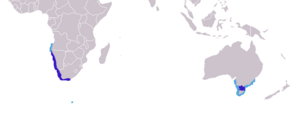Brown fur seal facts for kids
Quick facts for kids Brown fur seal |
|
|---|---|
 |
|
| Hauling-out on the Hippolyte Rocks off the east coast of Tasmania | |
| Conservation status | |
| Scientific classification | |
| Genus: |
Arctocephalus
|
| Species: |
pusillus
|
| Subspecies | |
|
|
 |
|
| Distribution of the brown fur seal, dark blue: breeding colonies; light blue: nonbreeding individuals | |
The brown fur seal (Arctocephalus pusillus) is a cool marine mammal that's actually a type of fur seal. You might also hear it called the Cape fur seal, South African fur seal, or Australian fur seal, depending on where it lives. These names come from the different places where these amazing animals are found.
What Do Brown Fur Seals Look Like?
Imagine a big, strong male brown fur seal! They are usually dark gray or brown, with a cool, shaggy mane of short, stiff hair around their neck. Their belly is lighter.
Female seals are a bit lighter, often light brown or gray. They have a pale throat and a darker back and belly. All brown fur seals have dark brown or black front flippers.
When baby seals (called pups) are born, they are black. But don't worry, they change color! Within three to five months, their fur turns gray with a pale throat.
Who Hunts Brown Fur Seals?
Brown fur seals have some powerful predators in the ocean. Their main hunter is the great white shark, a very famous and strong ocean predator.
Other animals that sometimes hunt brown fur seals include killer whales, which are also known as orcas. Even large southern elephant seals can be a threat to them.
On land, especially along the Skeleton Coast in Namibia, brown fur seals need to watch out for black-backed jackals and brown hyenas. These land animals will try to hunt the seals, especially the younger ones.
Images for kids
-
Fur seals used for tourist attraction in Namibia
See also
 In Spanish: Lobo marino australiano para niños
In Spanish: Lobo marino australiano para niños













